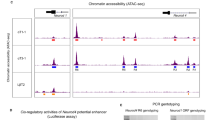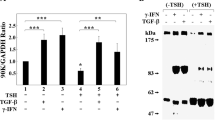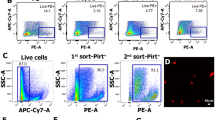Abstract
Can T cells be directly activated to de novo gene expression by gonadotropin-releasing hormone-II (GnRH-II), a unique 10-amino-acid neuropeptide conserved through 500 million years of evolution? GnRH-II, which has been identified in mammals1,2, shares 70% homology with the mammalian hypothalamic neurohormone GnRH (GnRH-I), the primary regulator of reproduction, but is encoded by a different gene3. Although both neuropeptides are produced mainly in brain, their localization1,2 and promoter regulation4,5 differ, suggestive of distinct functions. Indeed, GnRH-II barely affects reproduction1 and its role in mammalian physiology is unknown. We find here that human normal and leukemic T cells produce GnRH-II and GnRH-I. Further, exposure of normal or cancerous human or mouse T cells to GnRH-II or GnRH-I triggered de novo gene transcription and cell-surface expression of a 67-kD non-integrin laminin receptor that is involved in cellular adhesion and migration and in tumor invasion and metastasis. GnRH-II or GnRH-I also induced adhesion to laminin and chemotaxis toward SDF-1α, and augmented entry in vivo of metastatic T-lymphoma into the spleen and bone marrow. Homing of normal T cells into specific organs was reduced in mice lacking GnRH-I. A specific GnRH-I-receptor antagonist blocked GnRH-I- but not GnRH-II-induced effects, which is suggestive of signaling through distinct receptors. We suggest that GnRH-II and GnRH-I, secreted from nerves or autocrine or paracrine sources, interact directly with T cells and trigger gene transcription, adhesion, chemotaxis and homing to specific organs, which may be of clinical relevance.
This is a preview of subscription content, access via your institution
Access options
Subscribe to this journal
Receive 12 print issues and online access
$209.00 per year
only $17.42 per issue
Buy this article
- Purchase on Springer Link
- Instant access to full article PDF
Prices may be subject to local taxes which are calculated during checkout



Similar content being viewed by others
References
Chen, A. et al. A second isoform of gonadotropin-releasing hormone is present in the brain of human and rodents. FEBS Lett. 435, 199–203 (1998).
Lescheid, D.W. et al. A second form of gonadotropin-releasing hormone (GnRH) with characteristics of chicken GnRH-II is present in the primate brain. Endocrinology 138, 5618–5629 (1997).
White, R.B., Eisen, J.A., Kasten, T.L. & Fernald, R.D. Second gene for gonadotropin-releasing hormone in humans. Proc. Natl. Acad. Sci. USA 95, 305–309 (1998).
Chen, A., Laskar-Levy, O., Ben-Aroya, N. & Koch, Y. Transcriptional regulation of the human GnRH II gene is mediated by a putative cAMP response element. Endocrinology 142, 3483–3492 (2001).
Chen, A., Ziv, K., Laskar-Levy, O. & Koch, Y. The transcription of the hGnRH-I and hGnRH-II genes in human neuronal cells is differentially regulated by estrogen. J. Mol. Neurosci. 18, 67–76 (2002).
Azad, N. et al. Immunoactivation enhances the concentration of luteinizing hormone-releasing hormone peptide and its gene expression in human peripheral T-lymphocytes. Endocrinology 133, 215–223 (1993).
Josefsson, E., Bergquist, J., Ekman, R. & Tarkowski, A. Catecholamines are synthesized by mouse lymphocytes and regulate function of these cells by induction of apoptosis. Immunology 88, 140–146 (1996).
Krantic, S. Peptides as regulators of the immune system: emphasis on somatostatin. Peptides 21, 1941–1964 (2000).
Hand, P.H., Thor, A., Schlom, J., Rao, C.N. & Liotta, L. Expression of laminin receptor in normal and carcinomatous human tissues as defined by a monoclonal antibody. Cancer Res. 45, 2713–2719 (1985).
Satoh, K. et al. Cloning of 67-kDa laminin receptor cDNA and gene expression in normal and malignant cell lines of the human lung. Cancer Lett. 62, 199–203 (1992).
Suzuki, H. Expression of the 67-KD laminin-binding protein in human lymphomas. Hum. Pathol. 30, 361–362 (1999).
Canfield, S.M. & Khakoo, A.Y. The nonintegrin laminin binding protein (p67 LBP) is expressed on a subset of activated human T lymphocytes and, together with the integrin very late activation antigen-6, mediates avid cellular adherence to laminin. J. Immunol. 163, 3430–3440 (1999).
Gauczynski, S. et al. The 37-kDa/67-kDa laminin receptor acts as the cell-surface receptor for the cellular prion protein. EMBO J. 20, 5863–5875 (2001).
Millar, R. et al. A novel mammalian receptor for the evolutionarily conserved type II GnRH. Proc. Natl. Acad. Sci. USA 98, 9636–9641 (2001).
Neill, J., Duck, L., Sellers, J. & Musgrove, L. A gonadotropin-releasing hormone (GnRH) receptor specific for GnRH II in primates. Biochem. Biophys. Res. Commun. 282, 1012–1018 (2001).
Sixt, M. et al. Endothelial cell laminin isoforms, laminins 8 and 10, play decisive roles in T cell recruitment across the blood-brain barrier in experimental autoimmune encephalomyelitis. J. Cell Biol. 153, 933–946 (2001).
Levite, M., Cahalon, L., Hershkoviz, R., Steinman, L. & Lider, O. Neuropeptides, via specific receptors, regulate T cell adhesion to fibronectin. J. Immunol. 160, 993–1000 (1998).
Tham, T.N. et al. Developmental pattern of expression of the α chemokine stromal cell-derived factor 1 in the rat central nervous system. Eur. J. Neurosci. 13, 845–856 (2001).
Sarzotti, M., Baron, S. & Klimpel, G.R. EL-4 metastases in spleen and bone marrow suppress the NK activity generated in these organs. Int. J. Cancer 39, 118–125 (1987).
Levite, M. Neuropeptides, by direct interaction with T cells, induce cytokine secretion and break the commitment to a distinct T helper phenotype. Proc. Natl. Acad. Sci. USA 95, 12544–12549 (1998).
Levite, M. et al. Extracellular K(+) and opening of voltage-gated potassium channels activate T cell integrin function: physical and functional association between Kv1.3 channels and β1 integrins. J. Exp. Med. 191, 1167–1176 (2000).
Levite, M. et al. Dopamine interacts directly with its D3 and D2 receptors on normal human T-cells, and activates b1 integrin function. Eur. J. Immunol. 31, 3504–3512 (2001).
Dorsam, G., Voice, J., Kong, Y. & Goetzl, E.J. Vasoactive intestinal peptide mediation of development and functions of T lymphocytes. Ann. NY Acad. Sci. 921, 79–91 (2000).
Chen, A. et al. Two isoforms of gonadotropin-releasing hormone are coexpressed in neuronal cell lines. Endocrinology 142, 830–837 (2001).
Chen, A. et al. Two forms of gonadotropin-releasing hormone (GnRH) are expressed in human breast tissue and overexpressed in breast cancer: A putative mechanism for the antiproliferative effect of GnRH by down-regulation of acidic ribosomal phosphoproteins P1 and P2. Cancer Res. 62, 1036–1044 (2002).
Acknowledgements
We thank E. Flesher of the Sackler Faculty of Medicine, Tel Aviv University, for the EL-4 T-lymphoma cells and helpful discussions, and H. Otmi and R. Margalit for expert animal handling and surgery. This study was supported by grants from the Volkswagen-Stiftung Foundation and the Rochlin Foundation (to M.L.) and from the Israel Science Foundation (to Y.K).
Author information
Authors and Affiliations
Corresponding authors
Ethics declarations
Competing interests
The authors declare no competing financial interests.
Rights and permissions
About this article
Cite this article
Chen, A., Ganor, Y., Rahimipour, S. et al. The neuropeptides GnRH-II and GnRH-I are produced by human T cells and trigger laminin receptor gene expression, adhesion, chemotaxis and homing to specific organs. Nat Med 8, 1421–1426 (2002). https://doi.org/10.1038/nm1202-801
Received:
Accepted:
Published:
Issue Date:
DOI: https://doi.org/10.1038/nm1202-801
This article is cited by
-
Gonadotropin-Releasing Hormone Receptor Expression in Human Spinal Cord
Neurochemical Research (2021)
-
Towards Neuroimmunotherapy for Cancer: the Neurotransmitters Glutamate, Dopamine and GnRH-II augment substantially the ability of T cells of few Head and Neck cancer patients to perform spontaneous migration, chemotactic migration and migration towards the autologous tumor, and also elevate markedly the expression of CD3zeta and CD3epsilon TCR-associated chains
Journal of Neural Transmission (2014)
-
A case of polymyositis and vasculitis induced by ovulation induction therapy with gonadotropin-releasing hormone
Clinical Rheumatology (2010)
-
Differential expression of gonadotropin-releasing hormone (GnRH) in pancreas during rat pregnancy
Endocrine (2009)



